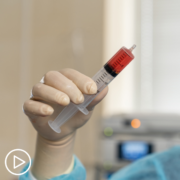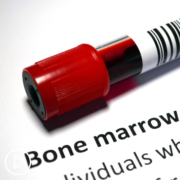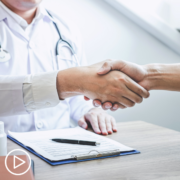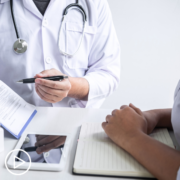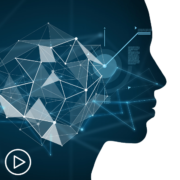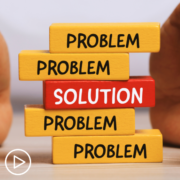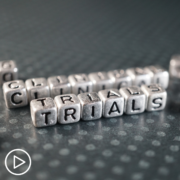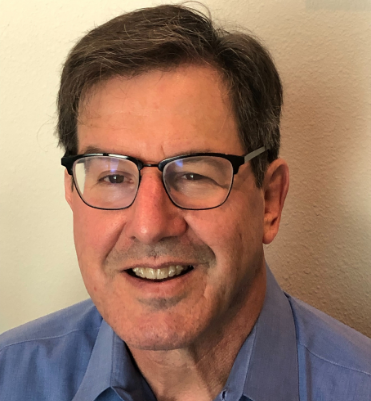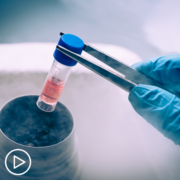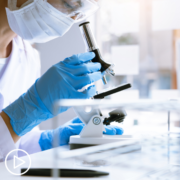What Are Key Acute Myeloid Leukemia Care Barriers and Solutions? from Patient Empowerment Network on Vimeo.
What are key barriers and solutions to acute myeloid leukemia (AML) care? Expert Dr. Andrew Hantel from Dana-Farber Cancer Institute and Harvard Medical School discusses factors that create AML care barriers, solutions to overcome barriers, and proactive patient advice to help ensure optimal care.
[ACT]IVATION TIP
“…patients and their families to be aware of where any specialized care facilities are near them, it might not be even so much geographically near as like within the same 10 miles, but it might be like, ‘What’s the nearest large facility that maybe is known for having clinical trials or other medical research?’ And just to reach out to them and ask, ‘Do you have telehealth consultations? What would it mean for me to come to you?’…and then talk to the actual physician who’s caring for them and say, ‘Is it safe for me to wait to talk to them, is it something where I do therapy now, and I should maybe go talk to them after I’ve received my initial therapy and have that discussion?’”
Download Resource Guide | Descargar guía de recursos
See More from [ACT]IVATED AML
Related Resources:
Transcript:
Lisa Hatfield:
Dr. Hantel, what are some of the key barriers that patients with AML encounter when accessing timely and effective care, and how can healthcare systems work to address these challenges?
Dr. Andrew Hantel:
That’s a great question. People with AML face significant barriers in accessing care, primarily due to the complexity and intensity of the treatment options that we have available. The landscape of those treatment options is really much different than it was even 10 years ago. We’ve had more than 10 novel drug approvals and extensions of treatments that are effective into groups such as older adults who have really previously had few good options and now have potentially many, and this has led to differences in what some of us call diffusion of innovation or how treatments are taken up and used by the medical community.
We kind of have some people who are usually at academic centers and are early adopters because they’ve seen some of these newer drugs and participate in the global trials, and then we have other community docs who see a lot of people with a variety of different cancers and kind of keep up with the literature, but to some extent aren’t as familiar with those new drugs and take some time before they start to incorporate them into practice.
And it is really important because in AML is not a disease that’s so common, so every oncologist sees patients with AML very frequently, and that kind of creates a difference between patients, people who are specialists, who are at the larger academic centers and people who are on the community and their need to really work together.
And this is a big point because treatments generally need to occur within a few weeks of diagnosis, if not much sooner, and therefore, all together this idea of new treatments kind of expanding out into the universe and also having the need for quick treatment means that geography really plays a crucial role in acting as a barrier to some patients getting what we think of as optimal care, especially for patients who live in rural or underserved areas that might not have access to these larger medical centers with specialized physicians, and then we also have financial challenges for those same patients and that getting into places is a major barrier, insurance to get to those places may have additional burdens that are placed in people with high costs that are associated with some of these treatments and healthcare systems have begun to address some of these challenges.
By really trying to enhance some local capacities such as through telemedicine consultations, kind of working in what we consider like a hub and spoke system where they have local providers reaching out to them and patients coming to them, at the time point of treatment decisions and then going back locally for a lot of their care, just so it’s not as burdensome in terms of travel, and then there’s also a lot of programs that are both within medical systems and outside of medical systems that are being helpful for patients, for financial guidance and assistance, such as through Leukemia & Lymphoma Society, which has wonderful programs, as well as kind of identifying partners for travel and housing grants and stipends that might be needed for caregivers, a lot of.
As I said, in a lot of centers like ours who are really trying to use any means possible to overcome these barriers for different patient groups, and a lot of it really depends on exactly what the person’s situation is, because so much of leukemia care is about the values of the patient and really how we’re targeting treatment, not only toward their disease, but really aligns with their goals, and so overcoming barriers is a really personal thing based on the values and the goals of the person who is in front of you.
Lisa Hatfield:
Great, thank you. And then one follow-up question I did have to that, as you mentioned that some patients are seen by their community oncologist, is it possible for a patient who is diagnosed with AML to do maybe one consult via telemedicine with a specialist in AML and maybe coordinate care that way, or do specialists typically like to have those patients present for regular visits?
Dr. Andrew Hantel:
Yeah, so I think the landscape of this is shifting in the past, I think no matter what, we have the idea that patients need to be safe, especially in the early days of their diagnosis, so it might be the case that somebody’s leukemia is diagnosed and they need treatment, it started immediately, and it’s not safe for them to wait, and it’s not safe for them to travel. But definitely there are other people who see their doctor and their blood counts are relatively stable, and the doctor thinks that it’s reasonable for them to get a second opinion, and these days, those opinions are happening yet still in person, sometimes centers like to see people in person.
But other times, as we said, those travel and distance and burdens can be so much that patients and these centers are turning to telehealth and other virtual forms of care that can at least provide a preliminary consultation and say, if you were to be seen here, we may have additional options like clinical trials or from what I’ve seen, I agree with what your physician is offering you and those more higher level decisions. And so it’s not so much whether or not even telehealth versus nothing, it’s kind of telehealth in person versus the need to get care immediately.
Lisa Hatfield:
Okay, that’s super helpful, thank you. And do you have an activation tip for this question, Dr. Hantel?
Dr. Andrew Hantel:
Yeah, I think the first thing is essentially just for patients and their families to be aware of where any specialized care facilities are near them, it might not be even so much geographically near as like within the same 10 miles, but it might be like, “What’s the nearest large facility that maybe is known for having clinical trials or other medical research?” And just to reach out to them and ask, “Do you have telehealth consultations? What would it mean for me to come to you?”
Those kinds of things, and then talk to the actual physician who’s caring for them and say, “Is it safe for me to wait to talk to them, is it something where I do therapy now, and I should maybe go talk to them after I’ve received my initial therapy and have that discussion?” And I think that leads into my kind of second or ancillary tip is to really don’t be afraid to ask your care teams about both of those things, and then about the logistics of what any of your care is going to mean in terms of the burdens of getting back and forth to clinic, having to be in the hospital and both for you as a patient as well as for your family.
Share Your Feedback About [ACT]IVATED AML
